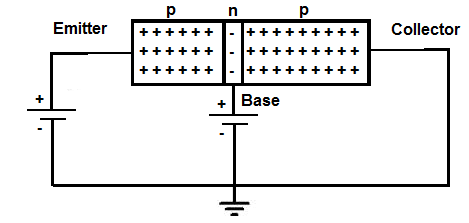

For proper working transistors in this circuits specific amount of current and voltage is needed. The point I was trying make, though, is that the originally posted circuit has a current source as a signal source rather than the voltage source most folks expect. In electronic devices and projects, transistors are very commonly used like amplifier and switch. It seems clear and correct to me, but it is written out of my self taught view of transistors. Looking back, I'm not sure I've made things any clearer. The example from your text book mixes voltage and current sources, and makes it difficult to see what is going on. The real tricky thing about transistor amplifiers is that transistors only have current gain, but the typical transistor circuits have voltage gain. In order to achieve that, V B E needs to be around 0.7 volts. The varying base current varies the collector current, which together with \$R1\$ varies the output voltage at \$VOut\$. Also, remember the magnitude of the energy hill required for forward-biasing the base-emitter. That current is multiplied with the \$\beta\$ of the transistor. With R3, the voltage at the base will stay at (about) 0.7V, but the current through the base will vary as the input signal voltage varies. If biasing a transistr mean WebFor a transistor to function.

#Transistor biasing meaning series#
A voltage source applied directly to the base will try to raise the voltage on the base above 0.7 V, and will pour in as much current as it takes to make that happen - rapidly resulting in a dead transistor.Ī voltage source in series with a resistor is (or approximates) a current source. Biasing a transistor Weball parameters depend on bias maintaining a stable bias is. Since V1 is a voltage source, you have to have R3 to limit the current. The voltage at the base ends up at (about) 0.7V because that's the forward voltage of the transistor's base-emitter junction - it acts like a diode. You've not picked a biasing voltage, you've picked a biasing current. (There's a lot more to it than that because you have to pick \$R1\$, and that depends on the transistor load line and other stuff. It's enough to simply label the voltages, as they are implicitly referred to the ground reference. AT B) F 2) A transistor ident erstellen which metho of biasing.

I've removed the batteries, as they really just add "noise" to the diagram without helping at all in understanding it. 1) Biasing a BJT amplifier means establishing dc operating voltages for proper operation. Simulate this circuit – Schematic created using CircuitLab It'll be easier to show what I mean, then. In digital and analog circuit MOSFET is commonly used than BJT. In today’s tutorial, we will have a look at MOSFET Bias Circuits.The MOSFET is type of FET and stands for metal oxide field effect transistor used as amplifier and switch in different circuit configuration. Let's look at it without regard to the AC, for a moment. Hello friends, I hope you all are doing great. The circuit you have is a highly non-linear one, even if you assume that the AC voltage itself is exactly zero volts, peak to peak.


 0 kommentar(er)
0 kommentar(er)
